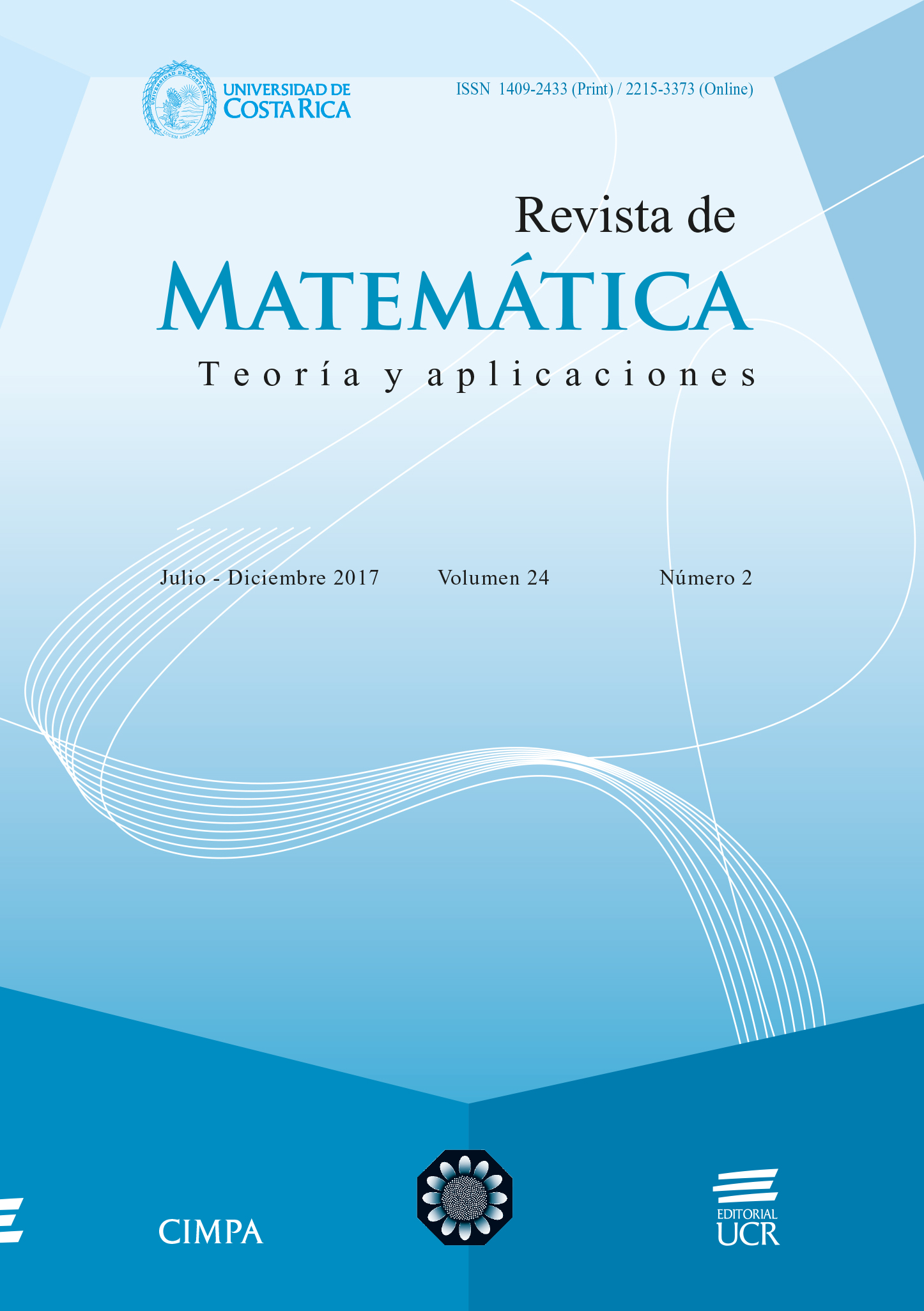Resumen
La matemática difusa generaliza los conceptos tradicionales de la matemática utilizando los llamados conjuntos difusos, lo que permite modelar y estudiar de manera más apropiada fenómenos caracterizados por su imprecisión. Estas generalizaciones incluyen conceptos de álgebra, análisis y topología, entre otros. Por otra parte, los complejos cúbicos tienen aplicaciones al procesamiento de imágenes digitales y al estudio de los sistemas dinámicos, pero en la literatura actual no hay una extensión de sus propiedades utilizando conjuntos difusos. En este documento se propone una generalización del concepto de complejo cúbico y de algunas de sus características, tales como realización poliédrica, conexidad, componente conexa y agujero, utilizando conjuntos difusos. Se definen los árboles superior e inferior de un complejo cúbico difuso, los cuales proporcionan información sobre la manera en la que están relacionados sus extremos regionales. También se definen los grupos de homología de estos complejos cúbicos difusos y se demuestra que el rango del 0-grupo de homología de un nivel dado es igual al número de máximos regionales de dicho nivel. Por último, se muestra cómo se le puede asociar un complejo cúbico difuso a una imagen digital bidimensional en tonos de gris para estudiar algunas de sus propiedades topológicas.
Citas
Allili, M.; Mischaikow, K.; Tannenbaum, A. (2001) “Cubical homology and the topological classification of 2D and 3D imagery”, en: Proceedings of the International Conference on Image Processing 2001, Vol. 2, IEEE, Grecia: 173–176.
Bairamov, S.; Gunduz, C. (2010) “The Čech homology theory in the category of Šostak fuzzy topological spaces”, International Journal of Contemporary Mathematical Sciences 5(9): 433–448.
Bykov, A.I.; Zerkalov, L.G. (1996) “Algorithms for homotopy classification of binary images”, Pattern Recognition 29(4): 565–574.
Bykov, A.I.; Zerkalov, L.G.; Albores Velasco, F.J.; Rodríguez Pineda, M. A. (1998) “New connected components algorithm and invariant transformations of digital images”, Pattern Recognition 31(8): 1089–1098.
Bykov, A.I.; Zerkalov, L.G.; Rodríguez Pineda, M.A. (1999) “Index of a point of 3-D digital binary image and algorithm for computing its Euler characteristic”, Pattern Recognition 32(5): 845–850.
Chang, C.L. (1968) “Fuzzy topological spaces”, Journal of Mathematical Analysis and Applications 24(1): 182–190.
Couprie, M.; Nivando Bezerra, F.; Bertrand, G. (1999) “Grayscale image processing using topological operators”, Proceedings SPIE Vision Geometry VIII 3811: 261–272.
Cuvalcioglu, G.; Citil, M. (2006) “On fuzzy homotopy theory”, Advanced Studies in Contemporary Mathematics 12(1): 163–166.
Kaczynski, T.; Mischaikow, K.; Mrozek, M. (2003) “Computing homology”, Homology, Homotopy and Applications 5(2): 233–256.
Kerre, E.E. (2005) “A historical overview of fuzzy mathematics”, New Mathematics and Natural Computation 1(1): 1–26.
Kong, T.Y.; Rosenfeld, A. (1989) “Digital topology: introduction and survey”, Computer Vision, Graphics and Image Processing 48: 357–393.
Li, S.G. (2000) “Connectedness in L-fuzzy topological spaces”, Fuzzy Sets and Systems 116(3): 361–368.
Lowen, R. (1978) “A comparison of different compactness notions in fuzzy topological spaces”, Journal of Mathematical Analysis and Applications 64: 446–454.
Lowen, R. (1980) “Convex fuzzy sets”, Fuzzy Sets and Systems 3(3): 291–310.
Lowen, R. (1981) “Connectedness in fuzzy topological spaces”, Rocky Mountain Journal of Mathematics 11(3): 427–433.
Lubczonok, P. (1990) “Fuzzy vector spaces”, Fuzzy Sets and Systems 38(3): 329–343.
Monasse, P.; Guichard, F. (2000) “Fast computation of a contrast-invariant image representation”, IEEE Transactions on Image Processing 9(5): 860–872.
Mrozek, M.; Batko, B. (2009) “Coreduction homology algorithm”, Discrete Computational Geometry 41: 96–118.
Najman, L.; Couprie, M. (2006) “Building the component tree in quasi- linear time”, IEEE Transactions on Image Processing 15(11): 3531–3539.
Niethammer, M.; Kalies, W.D.; Mischaikow, K.; Tannenbaum, A. (2006) “On the detection of simple points in higher dimensions using cubical homology”, IEEE Transactions on Image Processing 15(8): 2462–2469.
Rodríguez-Pineda, M.A. (1997) El Concepto de Índice de un Punto Lattice en el Análisis Homotópico de 2D y 3D Imágenes y su Realización Algorítmica. Tesis de doctorado, Benemérita Universidad Autónoma de Puebla, México.
Rosenfeld, A. (1971) “Fuzzy groups”, Journal of Mathematical Analysis and Applications 35(3): 512–517.
Rosenfeld, A. (1979) “Digital topology”, The American Mathematical Monthly 86(8): 621–630.
Rosenfeld, A. (1979) “Fuzzy digital topology”, Information and Control 40(1): 76–87.
Rosenfeld, A. (1983) “On connectivity properties of grayscale pictures”, Pattern Recognition 6(1): 47–50.
Salleh, A.R. (1993) “The homotopy property of the induced homomorphisms on homology groups of fuzzy topological spaces”, Fuzzy Sets and Systems 56(1): 111–116.
Sidky, F.I.; Mishref, M.A. (1991) “Fuzzy cosets and cyclic and abelian fuzzy subgroups”, Fuzzy Sets and Systems 43(2): 243–250.
Wang-Jin, L.; Chong-You, Z. (1985) “Singular homology groups of fuzzy topological spaces”, Fuzzy Sets and Systems 15(2): 199–207.
Ying-Ming, L.; Mao-Kang, L. (1996) Fuzzy Topology. World Scientific, Singapore.
Zadeh, L.A. (1965) “Fuzzy sets”, Information and Control 8(3): 238–253.
Zadeh, L.A.; Fu, K. S.; Tanaka, K.; Shimura, M. (1975) Fuzzy Sets and Their Applications to Cognitive and Decision Processes. Academic Press, New York.
Ziou, D.; Allili, M. (2002) “Generating cubical complexes from image data and computation of the Euler number”, Pattern Recognition 35(12): 2833–2839.
##plugins.facebook.comentarios##

Esta obra está bajo una licencia internacional Creative Commons Atribución-NoComercial-CompartirIgual 4.0.
Derechos de autor 2017 Adolfo Maceda-Méndez





